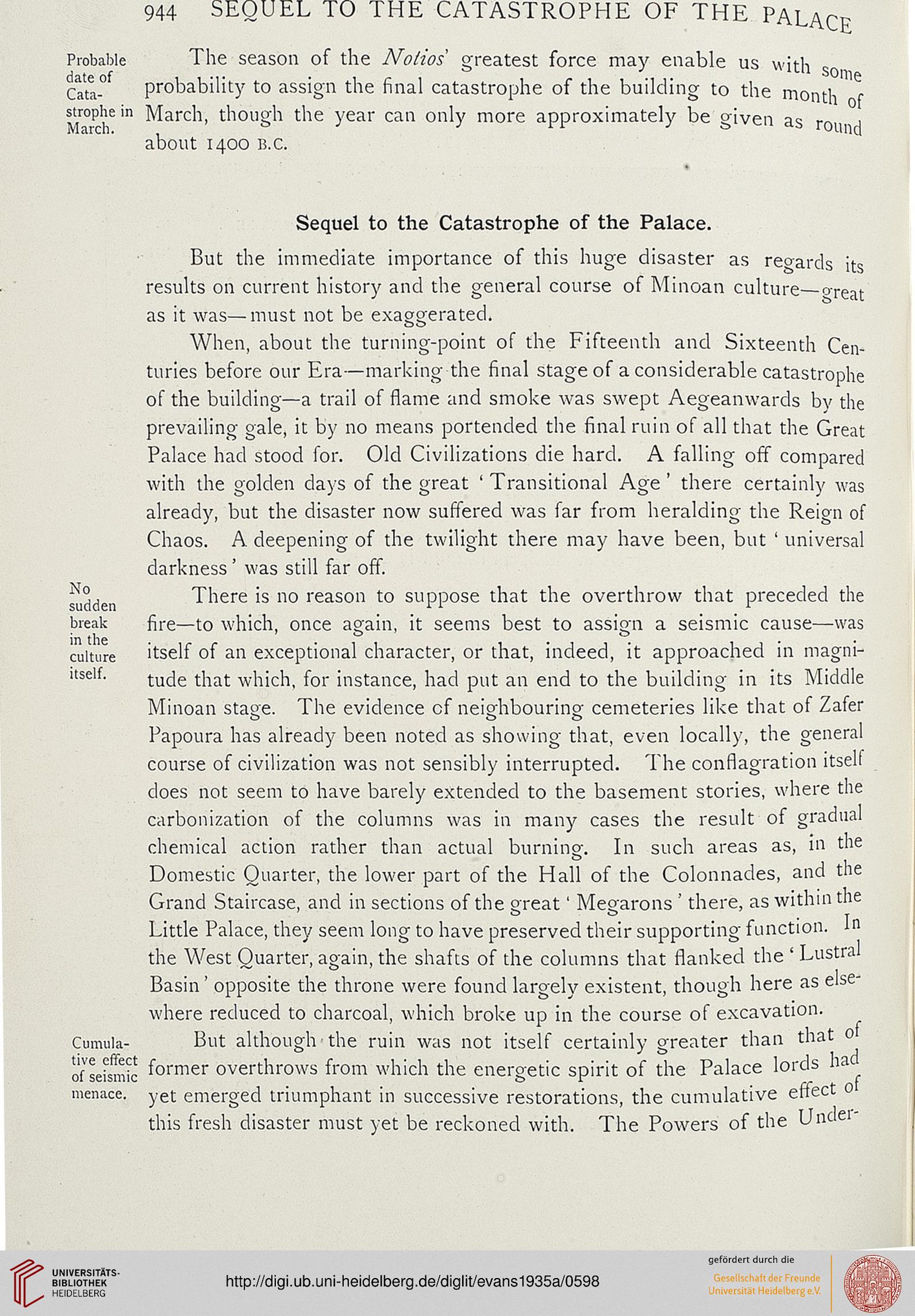944 SEQUEL TO THE CATASTROPHE OF THE PALACF
Probable The season of the Notios greatest force may enable us with
Cata" probability to assign the final catastrophe of the building to the month
strophe in March, though the year can only more approximately be eiven as ,-„ ,
March. ° ' L L J & b round
about 1400 B.C.
Sequel to the Catastrophe of the Palace.
But the immediate importance of this huge disaster as regards its
results on current history and the general course of Minoan culture—o-reat
as it was—must not be exaggerated.
When, about the turning-point of the Fifteenth and Sixteenth Cen-
turies before our Era—marking the final stage of a considerable catastrophe
of the building—a trail of flame and smoke was swept Aegeanwards by the
prevailing gale, it by no means portended the final ruin of all that the Great
Palace had stood for. Old Civilizations die hard. A falling off compared
with the golden days of the great ' Transitional Age' there certainly was
already, but the disaster now suffered was far from heralding the Reign of
Chaos. A deepening of the twilight there may have been, but ' universal
darkness ' was still far off.
There is no reason to suppose that the overthrow that preceded the
break fire—to which, once again, it seems best to assign a seismic cause—was
culture itself of an exceptional character, or that, indeed, it approached in magni-
itseif. tuc|e tnat wh;cnj for instance, had put an end to the building in its Middle
Minoan stage. The evidence of neighbouring cemeteries like that of Zafer
Papoura has already been noted as showing that, even locally, the general
course of civilization was not sensibly interrupted. The conflagration itself
does not seem to have barely extended to the basement stories, where the
carbonization of the columns was in many cases the result of gradual
chemical action rather than actual burning. In such areas as, in the
Domestic Quarter, the lower part of the Hall of the Colonnades, and the
Grand Staircase, and in sections of the great' Megarons ' there, as within the
Little Palace, they seem long to have preserved their supporting function. 1"
the West Quarter, again, the shafts of the columns that flanked the ' Lustral
Basin' opposite the throne were found largely existent, though here as else-
where reduced to charcoal, which broke up in the course of excavation.
Cumula- But although'the ruin was not itself certainly greater than that 0
ofleismS f°rmer overthrows from which the energetic spirit of the Palace lords had
menace. yet emerged triumphant in successive restorations, the cumulative effect 0
this fresh disaster must yet be reckoned with. The Powers of the Undel
No
sudden
Probable The season of the Notios greatest force may enable us with
Cata" probability to assign the final catastrophe of the building to the month
strophe in March, though the year can only more approximately be eiven as ,-„ ,
March. ° ' L L J & b round
about 1400 B.C.
Sequel to the Catastrophe of the Palace.
But the immediate importance of this huge disaster as regards its
results on current history and the general course of Minoan culture—o-reat
as it was—must not be exaggerated.
When, about the turning-point of the Fifteenth and Sixteenth Cen-
turies before our Era—marking the final stage of a considerable catastrophe
of the building—a trail of flame and smoke was swept Aegeanwards by the
prevailing gale, it by no means portended the final ruin of all that the Great
Palace had stood for. Old Civilizations die hard. A falling off compared
with the golden days of the great ' Transitional Age' there certainly was
already, but the disaster now suffered was far from heralding the Reign of
Chaos. A deepening of the twilight there may have been, but ' universal
darkness ' was still far off.
There is no reason to suppose that the overthrow that preceded the
break fire—to which, once again, it seems best to assign a seismic cause—was
culture itself of an exceptional character, or that, indeed, it approached in magni-
itseif. tuc|e tnat wh;cnj for instance, had put an end to the building in its Middle
Minoan stage. The evidence of neighbouring cemeteries like that of Zafer
Papoura has already been noted as showing that, even locally, the general
course of civilization was not sensibly interrupted. The conflagration itself
does not seem to have barely extended to the basement stories, where the
carbonization of the columns was in many cases the result of gradual
chemical action rather than actual burning. In such areas as, in the
Domestic Quarter, the lower part of the Hall of the Colonnades, and the
Grand Staircase, and in sections of the great' Megarons ' there, as within the
Little Palace, they seem long to have preserved their supporting function. 1"
the West Quarter, again, the shafts of the columns that flanked the ' Lustral
Basin' opposite the throne were found largely existent, though here as else-
where reduced to charcoal, which broke up in the course of excavation.
Cumula- But although'the ruin was not itself certainly greater than that 0
ofleismS f°rmer overthrows from which the energetic spirit of the Palace lords had
menace. yet emerged triumphant in successive restorations, the cumulative effect 0
this fresh disaster must yet be reckoned with. The Powers of the Undel
No
sudden




